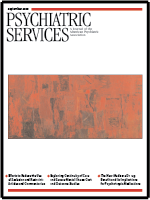Special Section on Seclusion and Restraint: Introduction to the Special Section
It has been more than 200 years since the French psychiatrist Philippe Pinel unchained the mentally ill patients in Paris's Bicêtre and La Salpêtrière Hospitals. Yet despite the subsequent advances in mental health treatment, we have been unable to completely free patients from the possibility of seclusion and restraint.
Seclusion and restraint are increasingly controversial, and with good reason. Acutely aggressive patients can pose a risk to themselves, other patients, and staff. But we also know that seclusion and restraint can be deadly. However, no medical literature guides us as to which methods are safer and under which circumstances. We also know that patients have described these experiences as negative at best, and as traumatic at worst. Of further concern, seclusion and restraint are not applied uniformly—numerous studies have shown considerable variation in their frequency and duration. Nonclinical factors, such as patients' ethnicity and level of staff experience, are known to be associated with the use of seclusion and restraint. Tellingly, quality improvement programs aimed at reducing seclusion and restraint have been successful, without increased risk to patients or staff. Indeed, some programs have seen reductions in such injury.
The critical question is not, "Can acutely aggressive patients pose a risk to themselves, other patients, and staff?" We know they can. The more relevant question is, "Can we do a better job of preventing or deescalating these situations so that we do not need to use seclusion, restraint, or emergency medication?" A considerable literature suggests we can.
This special section of Psychiatric Services contains five articles on seclusion and restraint. They describe varied and innovative approaches toward our understanding of these practices. The section also contains two commentaries: one by Charles G. Curie, M.A., A.C.S.W., and one by Robert W. Glover, Ph.D. Mr. Curie is administrator of the Substance Abuse and Mental Health Services Administration (SAMHSA) and was state mental health program director in Pennsylvania. Dr. Glover is executive director of the National Association of State Mental Health Program Directors.
First, Denis C. Donat, Ph.D., outlines key resources and tools for establishing quality improvement programs aimed at reducing seclusion, restraint, and use of as-needed medications. He emphasizes how behavioral approaches can be used toward that goal. He also notes the importance of establishing a quality assessment framework to measure the impact of the interventions implemented—or lack of an impact.
Next, Janice LeBel, Ed.D., and Robert Goldstein, Ph.D., present an economic analysis of the monetary costs of seclusion and restraint. Their research dispels concerns that decreasing seclusion and restraint will come at higher costs to the system and therefore may not be affordable. On the contrary, these authors demonstrate that seclusion and restraint cost a considerable amount in a state hospital budget and that dramatic reductions make more money available for other services.
In the third article, Gregory M. Smith, M.S., and colleagues describe in detail how the Pennsylvania state hospital system dramatically reduced—and nearly eradicated—its seclusion and restraint practices between 1990 and 2000. Pennsylvania is a powerful example of how systemwide quality improvement requires interventions on multiple levels. These authors describe how a cultural change within their system was critical to their success—a change that viewed the use of seclusion and restraint as treatment failure rather than as a treatment modality and that engaged frontline staff in developing this cultural and practice change.
Next, two companion articles by B. Christopher Frueh, Ph.D., and Cynthia S. Robins, Ph.D., and their colleagues give powerful expression to patients' experiences with traumatic and harmful events in psychiatric settings. These articles widen our understanding of a broader set of experiences patients can have on psychiatric units. They quantify the type, frequency, and distress attributed to a variety of traumatic and harmful patient experiences at the hands of police, clinical staff, and other patients. Dr. Robins and her coauthors give individual voice to these patients with a qualitative analysis of their interviews and common themes.
Finally, the commentaries by Mr. Curie and Dr. Glover articulate a vision for our mental health system as one of recovery in which patients have choices in their treatment. Both men have been leaders in successful efforts to reduce the use of seclusion and restraint. Mr. Curie challenges us further with SAMHSA's commitment to the eventual elimination of these practices.
Eliminating seclusion and restraint may feel to some like a radical, unrealistic goal. But the Pennsylvania state hospital system's experience teaches us that this goal may be possible. At the very least, we know that the use ofseclusion and restraint can be greatly reduced. By rising to this challenge, we can achieve Pinel's vision of treatment for persons with mental illness.
Dr. Busch is affiliated with the alcohol and drug abuse treatment program of McLean Hospital, Proctor Building, 115 Mill Street, Belmont, Massachusetts 02478 (e-mail, [email protected]). This article is part of a special section on the use of seclusion and restraint in psychiatric treatment settings, of which Dr. Busch is the guest editor.



